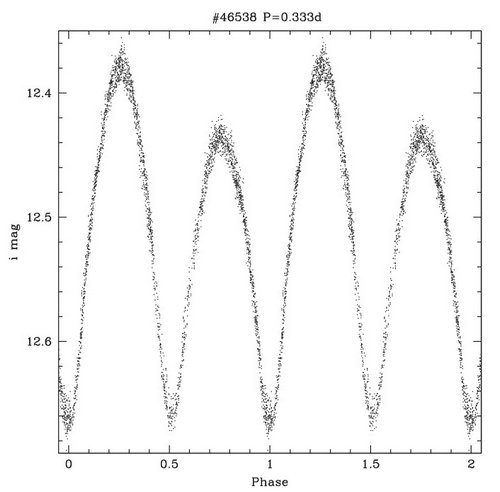Based on the time-series photometry of 3500 images recently detected by AST3-1 towards one Galactic disk field (l=289.635,b=-1.572), 560 variable stars were detected with i magnitude 16.5 mag during 8-day observations, 339 of these are previously unknown variables. We tentatively classify the 560 variables as 285 eclipsing binaries, 27 pulsating variable stars, and 248 other types. All of the variable stars will be included by AAVSO database and VizieR catalog.
Of the eclipsing binaries, 34 show O'Connell effects, i.e., the two successive out-of-eclipse maximum have unequal height in the light curves. The O'Connell effect can be explained by the star spots model and by the interaction of circumstellar material with the binary components. The interaction model suggests that the O'Connell effect is most obvious in late-type and/or short-period binaries. The binary AST46538 in Figure 1 with the spectral type of G8 and orbital period of 0.333 days exhibits the most obvious O'Connell effect, which is consistent with the interaction model. More observations are needed to double-check this analysis.
Thanks to the excellent atmosphere conditions, long-term high-precision time-series photometry is possible from the Dome A, Antarctica. Dome A (latitude 80°22′02′′S, longitude 77°21′11′′E, elevation
4093 m above the sea level) is the highest region on the Antarctic plateau and is being used by China for a series of increasingly ambitious observing instruments, i.e., AST3-1. The time-series data acquired from these instruments provide the important reference data for the Dome A site testing and polar research expedition.

Figure 1: The phased diagram of AST46538, which has the most significant O'Connell effect with a magnitude difference of 0.06 mag in i band between the first and second maximum out-of-eclipse brightness. Credit: National Astronomical Observatories, Chinese Academy of Sciences.
Article link: http://adsabs.harvard.edu/abs/2017AJ....153..104W













